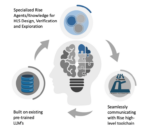Dr. Pradyumna (Prady) Gupta is the Founder and Chief Scientist at Infinita Lab and Infinita Materials, pioneering advancements in materials testing and specialized chemicals for cutting-edge industries. A passionate advocate for onshoring critical manufacturing industries, such as semiconductors, back to America, Prady is dedicated to fostering innovation that strengthens domestic supply chains and reinforces technological sovereignty.
At Infinita Lab— “Uber of Materials Testing”—Dr. Gupta leads network of over 2,000 labs that deliver solutions in metrology, materials testing, product validation, and ASTM/ISO standardized testing. Through Infinita Materials, he provides specialized chemicals and materials that power critical applications across semiconductors, electric vehicles, aerospace, and emerging technologies.
Prady’s career includes key roles at Saint-Gobain and Corning’s Gorilla Glass commercialization team. He co-founded multiple successful startups. An accomplished scientist, Prady holds several patents and has authored numerous research papers in materials science.
He holds an MBA from INSEAD / Wharton and a PhD in Materials Science, combining deep technical expertise with strategic business acumen. Prady’s entrepreneurial and scientific leadership continues to bridge today’s industrial needs with the innovations required to solve the challenges of tomorrow.
Tell us about your company.
I run two companies: Infinita Lab and Infinita Materials.
Infinita Lab is the “Uber” of materials testing, offering a comprehensive range of testing services. From advanced metrology techniques such as SEM, TEM, RBS, and XPS to environmental, dielectric, mechanical testing, and standardized ASTM or ISO testing, we provide it all through our network of 2,000+ accredited labs.
Our clients include industry leaders like Intel, Tesla, Applied Materials, and Lam Research, who rely on us to equip their engineers with a full spectrum of testing options. We are also the go-to lab for startups and smaller companies that lack in-house testing facilities.
Infinita Materials, on the other hand, specializes in delivering custom inorganic chemicals and sputtering targets for industries such as semiconductors, batteries, fuel cells, and electronics.
Clients value us because you’ll speak directly with a master-level materials scientist who can address your materials-related challenges—not just someone taking your contact information.
Based in Newark, California, we have a national reach thanks to our partnerships with accredited labs across the U.S. Our core services include nondestructive testing, advanced material characterization, chemistry analysis, vibration testing, and root cause failure analysis.
We collaborate with everyone from startups to Fortune 500 companies, tailoring our solutions to meet their unique needs. As an innovation partner, we are as invested in our clients’ success as they are.
What problems are you solving?
Engineers often face the tedious and time-consuming task of finding labs capable of performing the specific materials testing they need. This discovery challenges inspired Infinita Lab, designed to streamline and simplify the process.
Infinita Materials addresses the challenge of designing new compositions for the electronics and semiconductor industries. It’s currently costly and difficult for engineers to find specialized composition-making facilities. Many Chinese manufacturers overlook these needs due to low ROI in small-volume compositions. Additionally, confidentiality and communication issues arise. We guarantee confidentiality and provide consultancy from masters-level materials scientists, ensuring specialized composition needs are met efficiently.
What application areas are your strongest?
Infinita Lab’s strength lies in adapting to the unique needs of diverse industries. We’ve built a solid reputation in high-tech sectors like semiconductors, nanotechnology, and energy storage. For instance, in the semiconductor space, we assist companies with thermal and failure analysis to meet rigorous performance and reliability standards.
In the energy sector, we focus on testing advanced battery technologies and solar panel materials, ensuring they’re efficient and durable in extreme conditions. Aerospace is another area of expertise, where we perform vibration and nondestructive testing to ensure components meet safety-critical requirements.
For Infinita Materials, we target semiconductor sputtering targets and specialized inorganic powders used in electronics, batteries, fuel cells, superconductors, and other cutting-edge applications. Additionally, we’re exploring additive manufacturing as a growing field, leveraging our expertise to innovate in 3D-printed materials for high-tech and industrial applications.
What keeps your customers up at night?
If I had to sum it up, I’d say it’s uncertainty—uncertainty about product performance, meeting regulatory standards, or potential failures in the field. For R&D teams, it’s the pressure of innovation—getting their product to market before the competition while ensuring reliability and performance. For manufacturers, it’s the fear of supply chain risks or defective materials. It’s about ensuring consistent quality. A single material defect in a supply chain can lead to catastrophic failures, recalls, or even safety risks. Engineers often face the tedious and time-consuming challenge of finding labs capable of performing the specific material testing they need. Compliance is another challenge—meeting ISO, ASTM, and other standards, which is equally difficult to adhere to.
Our role is to make all of this easier. We help clients identify potential risks early, solve complex material-related problems, and ultimately give them confidence that their products will perform as expected. Whether it’s failure analysis for a semiconductor company or environmental durability testing for a solar manufacturer, we’re solving problems that can make or break our clients’ success.
We understand these pressures because we’ve seen them time and again. That’s why we focus on more than just testing—we help our clients see the bigger picture. Our detailed, transparent reports don’t just identify problems; they provide tailored solutions for different industries, giving our clients peace of mind knowing they’re staying ahead of the curve.
What does the competitive landscape look like and how do you differentiate?
The testing industry is diverse, with large players and smaller, specialized labs often dominating specific niches. This fragmented landscape frequently forces clients to juggle multiple providers to meet their varied testing needs.
At Infinita Lab, we stand apart by offering a comprehensive range of services through partnerships with accredited labs, ensuring everything is accessible under one roof.
Our primary competition comes from in-house labs. While convenient and easily accessible, in-house labs are often sub-optimal solutions that can significantly handicap engineers. Here’s why:
Lack of Incentives: Managers in in-house labs typically don’t have the incentive to optimize performance. I’ve seen firsthand how instruments are down half the time or turnaround times stretch to months.
Obsolete Infrastructure: Instruments and technician skills must keep pace with the rapid innovations in materials science. As technology advances at an accelerating rate, in-house labs are often obsolete even before they are set up. This trend is only going to accelerate with the advent of AI.
Convenience vs. Capability: While in-house labs are convenient, they often lack the resources and capacity to provide cutting-edge solutions. We are working to make external labs just as accessible as in-house facilities, without compromising on quality or innovation.
Our differentiation lies in the following:
Expert Access: A master-level materials scientist will personally pick up your call, offering the expertise and guidance you need.
Concierge Service: We provide a seamless and easy concierge service, ensuring your needs are promptly and efficiently met.
Comprehensive Solutions at a Fraction of the Cost: With our expansive network of over 2,000 labs in the US, we provide a complete range of services at a fraction of the cost compared to in-house labs or most external providers. Engineers can request any type of materials testing and receive it quickly and affordably—a powerful proposition that outpaces both in-house and external lab alternatives.
For Infinita Materials, the competitive landscape primarily features Japanese small companies that excel in specialized materials and chemicals. However, we differentiate ourselves through superior communication and a personalized approach. We provide clients with access to high-level experts, ensuring tailored discussions that lead to the creation of high-quality products. This personalized interaction sets us apart, offering both technical expertise and a consultative edge that many competitors lack.
What new features/technology are you working on?
At Infinita Lab and Materials, we’re always looking to push the boundaries. Right now, we’re investing in expanding our capabilities for next-generation materials. These materials hold enormous potential, but testing them requires specialized equipment and expertise—challenges we are stepping up to meet.
The evolving requirements for AI hardware, such as advanced packaging and memory, have introduced new testing challenges. With our unique vantage point of the testing industry as a whole, we are leading the charge to upgrade and prepare the industry for these upcoming demands.
At Infinita Lab, we are working on:
- A UPS-like tracker to better predict turnaround times (TAT) for samples in the lab.
- A simplified system for sending samples for analysis.
- A system to provide more testing options and better match testing needs with appropriate testing methods.
With Infinita Materials, we are addressing the challenge of designing new compositions for the electronics and semiconductor industries. Currently, it is both costly and difficult for engineers to locate specialized composition-making shops. Chinese manufacturers often find small-volume specialized compositions unattractive in terms of ROI. Additionally, issues surrounding confidentiality and communication further complicate the process.
We guarantee confidentiality and provide access to master-level materials scientists who offer expert consultancy on specialized compositions, ensuring high-quality solutions tailored to our clients’ needs.
How do customers normally engage with your company?
We strive to make the process seamless and straightforward. It typically begins with a conversation where clients outline their problem or testing needs. What sets us apart is that when you call Infinita Lab, you are greeted by a master-level materials scientist—not just someone taking your contact information. This expert access ensures that your concerns are addressed immediately, with tailored guidance and actionable insights. Together, we define the project scope. If additional support is needed, our experts are available around the clock to provide guidance.
For Infinita Materials, clients often engage with us for specialized compositions, such as semiconductor sputtering targets or custom inorganic powders. Our master-level experts work closely to understand their unique requirements, guaranteeing confidentiality and precision throughout the process. Our clients value this highly personalized approach, which includes direct access to experts who can discuss and refine their needs in detail. We provide a seamless, efficient concierge experience, ensuring your needs are met promptly and without unnecessary hurdles. With our expansive network of over 2,000 labs in the U.S., we offer a complete range of services quickly and affordably. Engineers can request any type of materials testing, confident they’ll receive high-quality results at a fraction of the cost compared to in-house labs or external providers.
Many of our clients build long-term relationships with us, treating Infinita Lab and Infinita Materials as extensions of their teams. One of the most rewarding aspects of our work is seeing these partnerships empower our clients to achieve their goals and push the boundaries of innovation.
Also Read:
Executive Interview: Steve Howington of the High Performance Flooring Division of Sherwin-Williams
2025 Outlook with Sri Lakshmi Simhadri of MosChip
CEO Interview: Mouna Elkhatib of AONDevices











